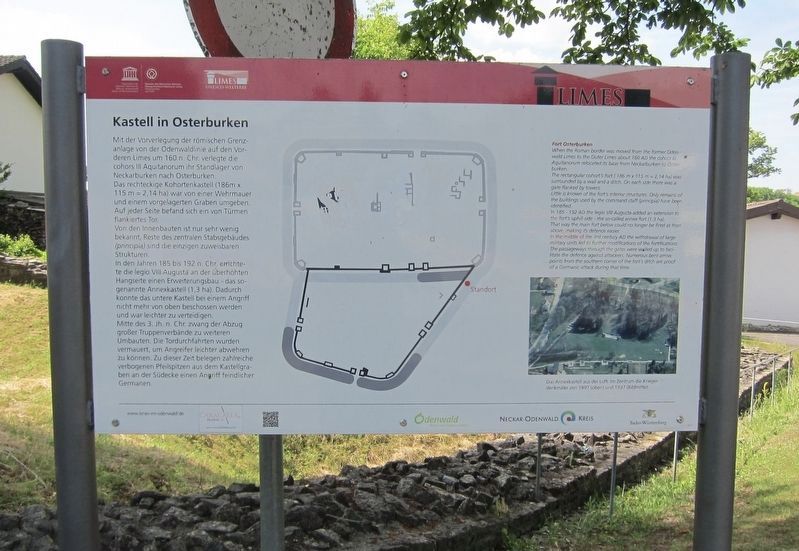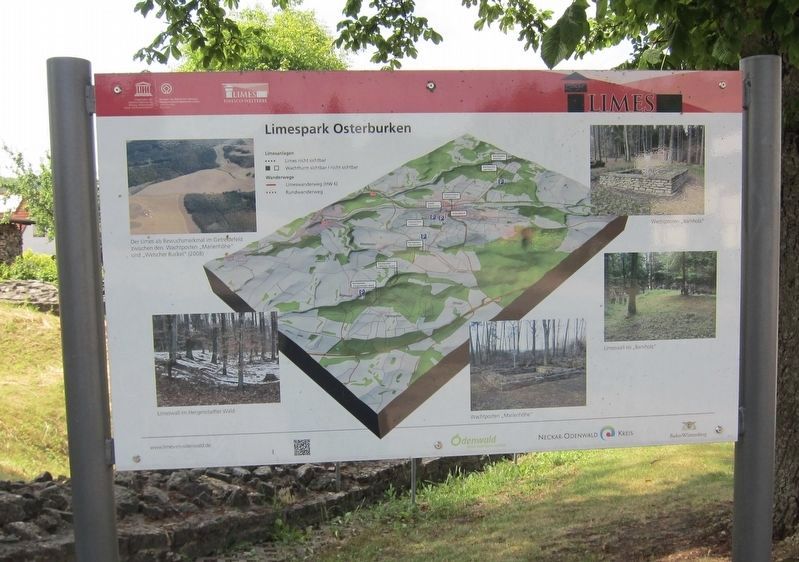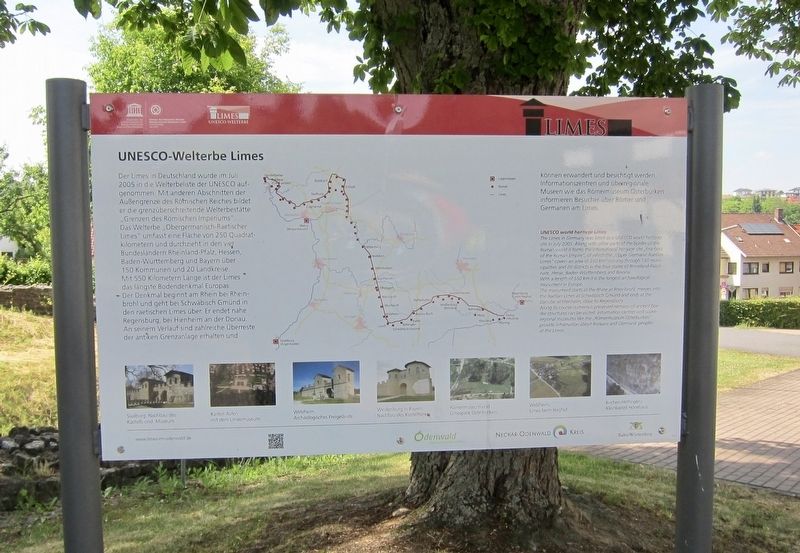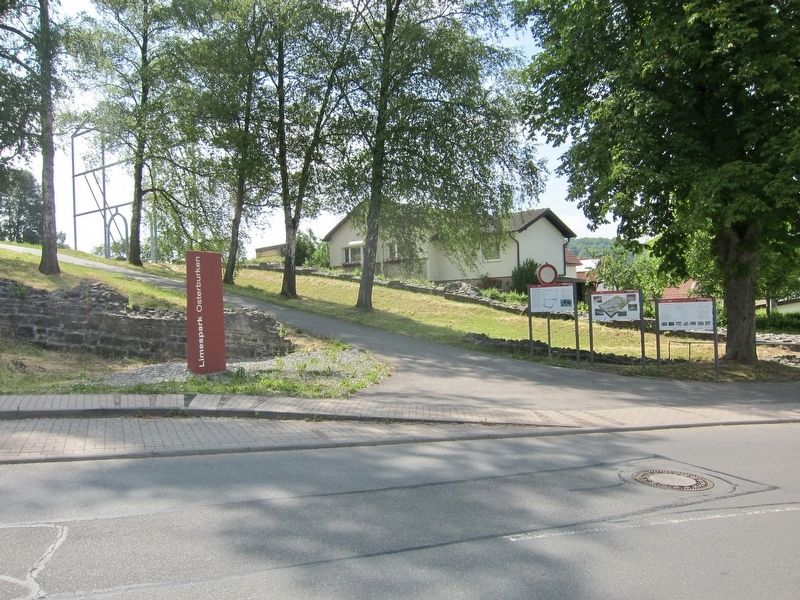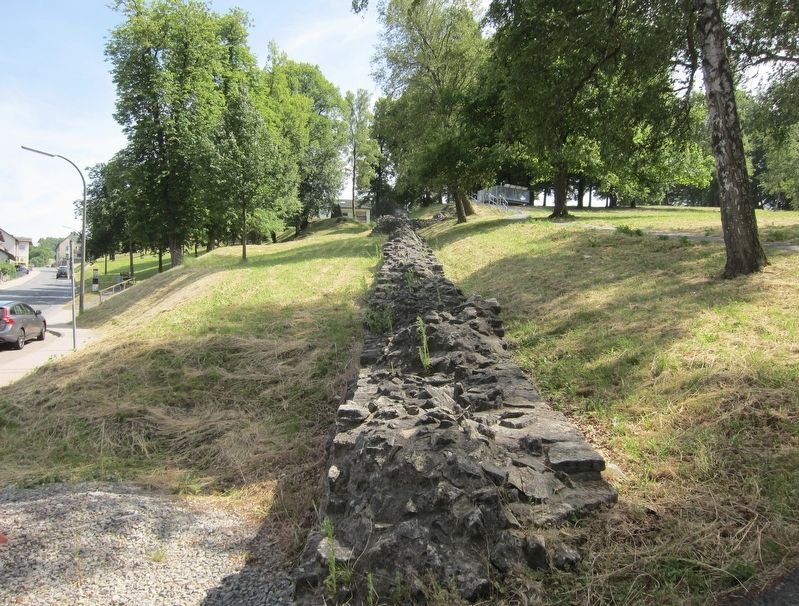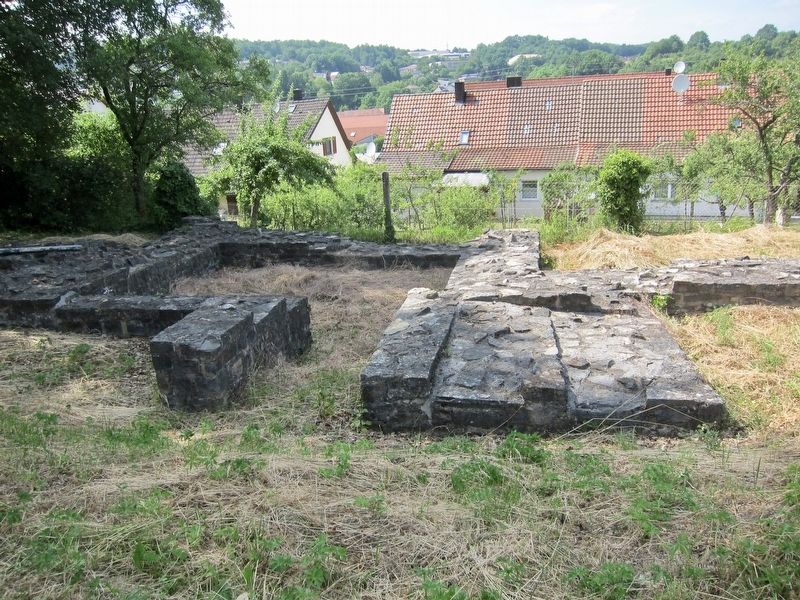Osterburken in Neckar-Odenwald-Kreis, Baden-Württemberg, Germany — Central Europe
Kastell in Osterburken / Fort Osterburken
Inscription.
(left panel:)
Mit der Vorverlegung der römischen Grenzanlage von der Odenwaldlinie auf den Vorderen Limes um 160 n. Chr. verlegte die cohors III Aquitanorum ihr Standlager von Neckarburken nach Osterburken.
Das rechteckige Kohortenkastell (186m x 115 m = 2,14 ha) war von einer Wehrmauer und einem vorgelagerten Graben umgeben. Auf jeder Seite befand sich ein von Türmen flankiertes Tor.
Von den Innenbauten ist nur sehr wenig bekannt, Reste des zentralen Stabsgebäudes (principia) sind die einzigen zuweisbaren Strukturen.
In den Jahren 185 bis 192 n. Chr. errichte-te die legio VIII Augusta an der überhöhten Hangseite einen Erweiterungsbau - das sogenannte Annexkastell (1,3 ha). Dadurch konnte das untere Kastell bei einem Angriff nicht mehr von oben beschossen werden und war leichter zu verteidigen.
Mitte des 3. Jh. n. Chr. zwang der Abzug großer Truppenverbände zu weiteren Umbauten. Die Tordurchfahrten wurden vermauert, um Angreifer leichter abwehren zu können. Zu dieser Zeit belegen zahlreiche verbogenen Pfeilspitzen aus dem Kastellgraben an der Südecke einen Angriff feindlicher Germanen.
-
When the Roman border was moved from the former Odenwald Limes to the Outer Limes about 160 AD the cohors Aquitanorum relocated its base from Neckarburken to Osterburken.
The rectangular cohort's fort (.186 m x 115 m = 2,14 ha) was surrounded by a wall and a ditch. On each side there was a gate flanked by towers.
Little is known of the fort's interior structures. Only remains of the buildings used by the command staff (principia) have been identified.
In 185 - 192 AD the legio VIII Augusta added an extension to the fort's uphill side - the so-called annex fort (1,3 ha). That way the main fort below could no longer be fired at from above, making its defence easier.
In the middle of the 3rd century AD the withdrawal of large military units led to further modifications of the fortifications. The passageways through the gates were walled up to facilitate the defence against attackers. Numerous bent arrow points from the southern corner of the fort's ditch are proof of a Germanic attack during that time.
-
(right panel:)
Der Limes in Deutschland wurde im Juli 2005 in die Welterbeliste der UNESCO aufgenommen. Mit anderen
Abschnitten der Außengrenze des Römischen Reiches bildet er die grenzüberschreitende Welterbestätte „Grenzen des Römischen Imperiums".
Das Welterbe „Obergermanisch-Raetischer Limes" umfasst eine Fläche von 250 Quadrat-kilometern und durchzieht in den viel Bundesländern Rheinland-Pfalz, Hessen, Baden-Württemberg und Bayern über 150 Kommunen und 20 Landkreise.
Mit 550 Kilometern Länge ist der Limes das längste Bodendenkmal Europas. Der Denkmal beginnt am Rhein bei Rheinbrohl und geht bei Schwäbisch Gmünd in den raetischen Limes über. Er endet nahe Regensburg, bei Hienheim an der Donau. An seinem Verlauf sind zahlreiche Überreste der antiken Grenzanlage erhalten und können erwandert und besichtigt werden. Informationszentren und überregionale Museen wie das Römermuseum Osterburken informieren Besucher über Römer und Germanen am Limes.
-
The Limes in Germany was listed as a UNESCO world heritage site in July 2005. Along with other parts of the border of the Roman world it forms the international heritage site „Frontiers of the Roman Empire", of which the „Upper Germanic-Raetian Limes" covers an area of 250 km2 running through 150 municipalities and 20 districts in the four states of Rhineland-Palatinate, Hesse, Baden-Württemberg and Bavaria.
With a length of 550 km it is the
longest archaeological monument in Europe.
The monument starts at the Rhine at Rheinbrohl, merges into the Raetian Limes at Schwäbisch Gmünd and ends at the Danube at Hienheim, close to Regensburg.
Along its course numerous preserved remains of ancient border structures can be visited. Information centres and supra-regional museums like the „Römermuseum Osterburken" provide information about Romans and Germanic peoples at the Limes.
Erected 2011.
Topics. This historical marker is listed in this topic list: Forts and Castles. A significant historical month for this entry is July 2005.
Location. 49° 25.631′ N, 9° 25.529′ E. Marker is in Osterburken, Baden-Württemberg, in Neckar-Odenwald-Kreis. Marker is on Kastellstraße just south of Am Finkenrain, on the left when traveling north. Touch for map. Marker is in this post office area: Osterburken BW 74706, Germany. Touch for directions.
Other nearby markers. At least 1 other marker is within walking distance of this marker. Werkzeugdepot / Tool Cache (within shouting distance of this marker).
Also see . . .
1. Römermuseum Osterburken (Roman Museum Osterburken.). Museum website homepage (Submitted on September 6, 2018.)
2. Limes Germanicus. Wikipedia entry:
"The Limes Germanicus (Latin for Germanic frontier) was a line of frontier (limes) fortifications that bounded the ancient Roman
provinces of Germania Inferior, Germania Superior and Raetia, dividing the Roman Empire and the unsubdued Germanic tribes from the years 83 to about 260 AD. At its height, the limes stretched from the North Sea outlet of the Rhine to near Regensburg (Castra Regina) on the Danube. Those two major rivers afforded natural protection from mass incursions into imperial territory, with the exception of a gap stretching roughly from Mogontiacum (Mainz) on the Rhine to Castra Regina....The total length was 568 km (353 mi). It included at least 60 forts and 900 watchtowers...." (Submitted on September 6, 2018.)
Credits. This page was last revised on April 18, 2024. It was originally submitted on September 6, 2018, by Andrew Ruppenstein of Lamorinda, California. This page has been viewed 238 times since then and 31 times this year. Photos: 1, 2, 3, 4, 5, 6. submitted on September 6, 2018, by Andrew Ruppenstein of Lamorinda, California.
